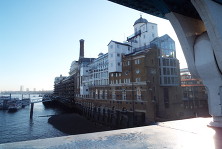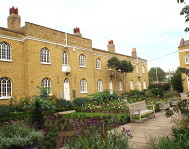








Beeston's Gift Almshouses
Beeston’s Gift Almshouses were erected in what is now called Consort Road in 1834. There were seven houses originally paid for by a charity established from a bequest by Cuthbert Beeston, a past Master of the Girdlers Company who administer the charity. By the terms of Cuthbert Beeston’s will of 1580, a parcel of land in Southwark known as The Cage and seven other tenements were bequeathed to the Master and Wardens of the Girdlers’ Company, subject to the life interest of his wife Alice. A sum from income derived from the land was to be given to the Stewards of the Girdlers Company for quarterly
dinners and, for ten years after the death of his wife, four sermons were to be preached annually and a sum set aside to pay the preacher. Coal was to be distributed twice a year to the poorest of the parish of St Stephen, Coleman Street and the Clerk and Beadle were to be paid a small sum for their help in the distribution. The remainder, and the larger part of the rents received, was to be invested in stock and lent freely to the poorest men of the Girdlers’ Company for the term of one year and free from interest.
The charity was administered along these lines until 1824 when the land in Southwark was required for the building of the new London Bridge. The land was sold for a good price and the money invested in stocks. The Girdlers’ Company made application to the Charity Commissioners who agreed that the original intentions of Cuthbert Beeston’s will were now impracticable and a scheme was drawn up for the building and endowment of almshouses for the reception and maintenance of aged and decayed brothers of the Girdlers’ Company, and their widows. Seven almshouses were subsequently built in Consort Road (then called Nunhead Road) that overlook a green with trees to the front and with individual gardens to the rear. The Master and Wardens of the Company visited on quarter days to distribute pensions and, until the custom fell by the wayside, the pensioners visited Girdlers’ Hall after Livery dinners to be given broken meats and a bottle of Pensioners’ port served by the Master and Wardens wearing large white aprons. The Pensioners also benefitted from another bequest in 1833 from Richard Mountford who left sums to be distributed amongst the poor of the Company for the purchase of coals twice a year.
By the 1980s, the Beeston Charity had merged with the Palyn Charity, together with other charities that came within the Girdlers’ Company’s administration. George Palyn had also been a Master of the Girdlers’ Company and the charity named after him had built six almshouses in Choumert Road in 1852 but these were sold and the residents moved to an enlarged Beeston’s almshouses in Consort Road. Two further wings were built on the which now offers accommodation for 24 residents in a total of 17 units.
Today the joint almshouses of Beeston’s and Palyn’s Charities are administered from Girdlers Hall in the City of London. When a vacancy occurs, which happens very rarely, applications are prioritised within the criteria of the scheme that governs the charity. In order of priority, consideration is given to “poor persons” who are:
-Freemen of the City of London.
-Persons who are, or who have been, employed in trades similar to that of a girdler (including workers in metals, leather cloth and fabrics).
-Persons resident in the former administrative county of London as constituted on 31st March 1965 i.e. in the area covered by the former London County Council.
Web discoveries
- UK Casino Not On Gamstop
- UK Casino Not On Gamstop
- Non Gamstop Casino
- Casinos Not On Gamstop
- Non Gamstop Casinos
- Non Gamstop Casinos
- Non Gamstop Casino
- Casino Sites Not On Gamstop
- Slots Not On Gamstop
- Casinos Not On Gamstop
- UK Betting Sites Not On Gamstop
- UK Casino Not On Gamstop
- Best Non Gamstop Casinos
- Betting Sites
- Non Gamstop Casino Sites UK
- Best Non Gamstop Casinos
- Non Gamstop Casino
- Casinos Not On Gamstop
- Non Gamstop Casino Sites UK